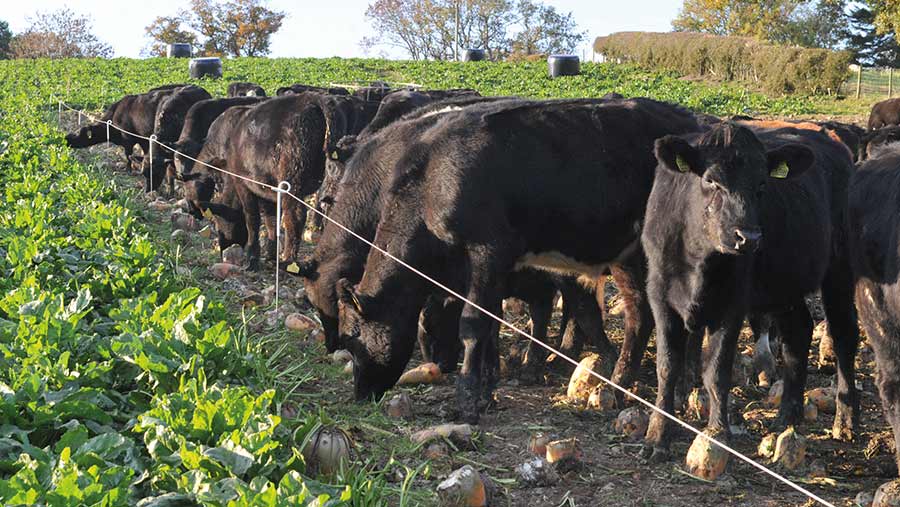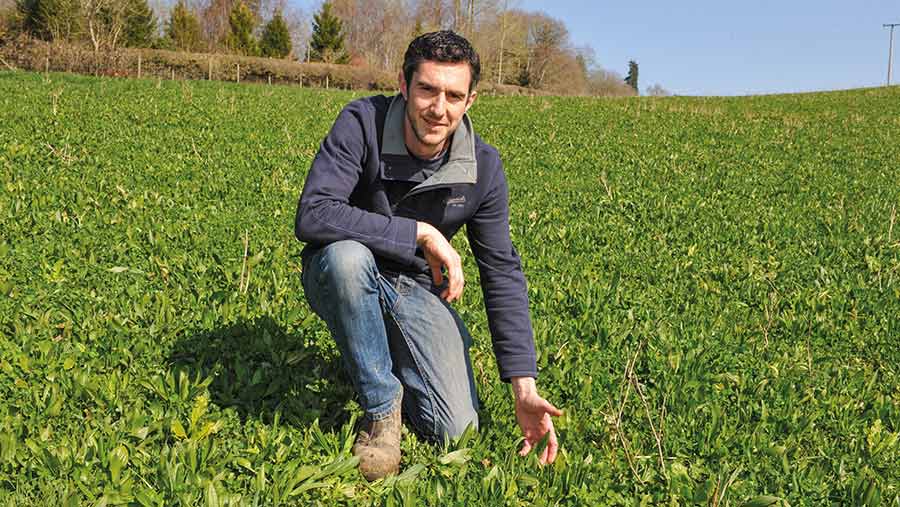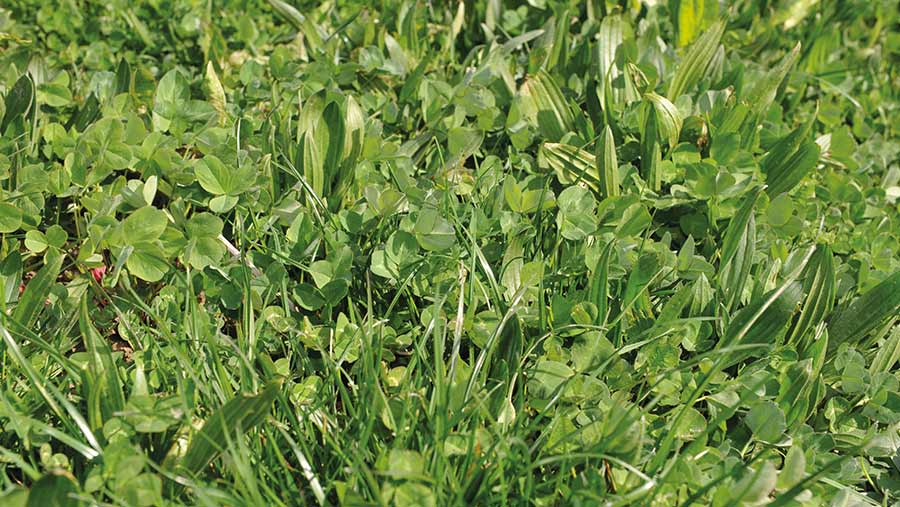Why a dry upland farm is switching to herbal leys
 Cattle on fodder beet © Debbie James
Cattle on fodder beet © Debbie James Increasing spells of dry weather have prompted beef and sheep farmer Marc Jones to roll out a programme of reseeding with herbal leys across more than two-thirds of his farm.
So far, the move has resulted in higher forage output, lower fertiliser bills and improved livestock performance.
Trefnant Hall Farm, on the Powis estate near Welshpool, sits in a rain shadow – while rain might be falling steadily just a couple of miles away, the farm often stays dry.
See also: Experiment shows potential for cell-grazing herbal leys
In 2021, annual rainfall totalled just 670mm. This is similar to Cambridge, even though some of the land is at 300m above sea level. And only 200mm of that fell during the grazing period.
This dearth of moisture is the principal reason why Mr Jones – the 2021 British Grassland Society Grassland Farmer of the Year – is switching to more diverse swards.

Marc Jones © Debbie James
Farm facts
- 202ha (499 acres) sandy silt soil with underlying shale
- 900 cattle, bought as autumn-born reared calves, or at 130-140kg in January, and sold at 22-24 months through the Tesco Aberdeen Angus premium scheme
- 700 New Zealand Romney ewes, sold through Tesco Cost of Production scheme
- All lambs finished off herbal leys and sold before the end of October
“Daily grass growth is often down as low as 5kg dry matter [DM]/ha on the ryegrass leys during dry spells,” says Mr Jones, who farms with his parents, David and Jane.
“The grass gets stressed and burns off completely or goes to head.”
Most of the farm was reseeded with high-sugar grasses and white clover mixes 10 years ago, when the farm transitioned to rotational grazing.
However, prolonged dry periods have since become the norm amid climate change. Grass performance has diminished, from an average of 12t DM/ha to 8t.
In 2018 the farm averaged just 6t DM/ha.
Mr Jones is now moving away from a seed mix with nearly 50% perennial ryegrasses to one with just 13.47% ryegrass.
So far, 61ha (151 acres) have been planted with chicory, plantain, timothy, cocksfoot, bird’s-foot trefoil, red clover and ryegrass.
The plan is to have about 142ha (385 acres) – or 70% of the farm – down to herbal leys by 2023.
“Our priority is to have feed availability in those very dry periods,” he says.
The impact on performance has been significant. On the more extreme south-facing banks, fields are now growing 8-10t DM/ha without fertiliser – fields that struggled to grow 4t of grass with fertiliser.
Establishment of herbal leys

© Debbie James
Entry crop
Many of the leys have been established after fodder beet, grown as an outwintering crop for cattle.
Fields are ploughed and sown initially with a quick-growing ley incorporating red clover and Westerwolds.
Two cuts of silage are taken before the herbal seed mixes are direct-drilled in the autumn.
Timing
Mr Jones favours an autumn reseed to allow the ley time to establish before a dry period, a lesson learned after a failed spring reseed in 2018.
“We planted 20ha (50 acres) and didn’t get rain for weeks. When we did get moisture in late July, the ryegrass outcompeted the other plants,” he says.
“We topped it up at half the original seed rate because we didn’t know if the seed had germinated and failed, or if it was just sitting there, but we ended up with a poor field of ryegrass.”
In fields that have not been ploughed, the grass is sprayed with glyphosate and direct-drilled, generally in the spring.
Fertility
The shallow soils at Trefnant Hall Farm have a pH of 6.2 or 6.3 and the phosphorus (P) and potassium (K) indexes average 2. No nitrogen is applied at establishment.
Weed control
Thistles, docks and other perennial weeds are sprayed the year before establishment. One of the drawbacks of herbal leys is that they cannot be sprayed, says Mr Jones, so it is important to get on top of weeds before planting.
Topping up
Leys are rejuvenated every three or four years by overseeding with a Unidrill or a harrow and air seeder.
There is a cost to this, but because no fertiliser is applied to the herbal ley, the cost base is much lower than ryegrass.
“Topping up makes financial sense,” he says.
Grazing management
The leys are grazed at opening covers of 3,500-4,000kg DM/ha, to a residual of 2,000kg DM/ha.
“We will graze a mob of 300 cattle on paddocks of one or two hectares, depending on the time of the year, and move them every one or two days,” he says.
While the ryegrasses need a 21- to 25-day grazing rotation, experience has shown the herbs and legumes need 30-35 days.
“We were finding that the ryegrass was going to head. And in a poor establishment year the ryegrass outcompetes everything else,” he says.
A root and soil conditioner of humic acid, molasses and fulvic acid is included in the mix to increase the plant’s root system and to promote uptake of glyphosate.
By using this, Mr Jones can reduce glyphosate use by 20%.
Livestock performance
The benefits of herbal leys for soil organic matter are well documented, but Mr Jones says he is not growing them for that reason alone. Animals have to perform – and they are.
He took part in an Innovative Farmers trial in 2021, grazing 100 New Zealand Romney ewes on a herbal ley and 100 on a good-quality grass and clover ley at tupping.
The result was an 18% higher scanning rate on the herbal ley, at 193% compared with 175%.
The ewes were turned on to both leys 10 days prior to tupping and remained there for two weeks post-tupping.
Cattle are performing, too, achieving an average daily liveweight gain (DLWG) of 0.8-1kg in cattle under 12 months of age.
“The ryegrass had been going straight through them, but they are not loose on the herbal leys because the metabolisable energy and digestible fibre are very good,” says Mr Jones.
However, he has found the ground can be soft and there is a high risk of poaching when using a high percentage of herbs and legumes.
“We don’t graze them too hard in the autumn because they need a rest in the winter to get going again by the beginning of April,” he says.
“We generally graze up until October. We can go later but that will mean we won’t be able to graze them [again] until late April.
“After our 2021 scanning results, we are considering whether we are better off tupping on the herbal leys, though, and getting the better performance then.”
Trefnant Hall Farm will host a British Grassland Society summer walk on 24 May 2022.
For more information about field labs go to innovativefarmers.org/field-lab
Marc Jones’ top tips for growing herbal leys
- Clear weeds the season before establishment
- Autumn establishment (by mid-August) works best – spring reseeds are at the mercy of a dry spell
- Sow no more than 1cm deep
- Use mixes with three or four different varieties of herbs, and a similar number of legumes and of grasses
